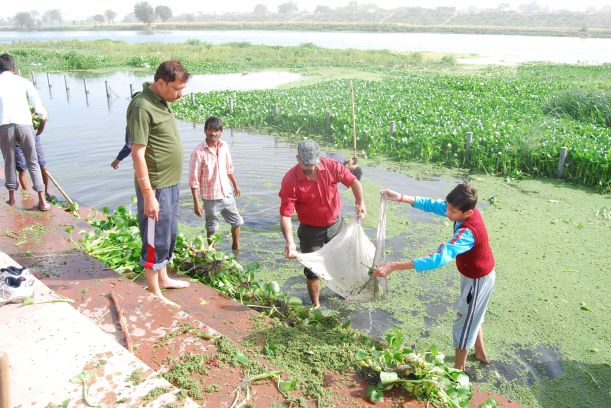

Water hyacinth over the Gomti River hides the threat to aquatic life
The Gomti river in India’s most populous and political heartland state of Uttar Pradesh is dying.
A survey carried out by a team of environmentalists of the BBA University in Lucknow has found that the condition of the river is so bad that the water in it is no longer fit for human consumption or able to sustain aquatic life.
The team found that the dissolved oxygen (DO) in the river has dipped to 0.5 mg/litre. It should be at least 8.5 mg/litre to make the water fit for human consumption while a drop below 5 mg/litre makes it unfit for flora and fauna. In 2013, the level recorded was 1 mg/litre.
The study was conducted by Professor Venkatesh Dutta, an environmental management specialist with specialisation in water resources management, and his team at the central university. The survey brought forward some alarming findings, explaining as to why only eight of the 51 species of fishes are left in the river. The survey said that barring water hyacinth, no other plant species have survived the slow death of the river.
[related_post]
“The DO level was 5 mg/litre only between Ghaila and Gaughat in the upstream. Thereafter, the water was found to be increasingly poor in quality due to untreated discharge from sewers and drains. The stretch near Shaheed Smarak, Shani Mandir Ghat and Kudiya Ghat is the most polluted, with the DO level being as low as 0.6 mg/litre, 0.5 mg/litre and 0.8 mg/litre, respectively,” Professor Dutta said in the report.
Once a lifeline and the main source of drinking water to the city of Lucknow, Gomti river remains remains highly polluted and its condition is expected to worsen in the current summer months. The reduced flow of water in the river had added to its misery, further lowering the oxygen level.
The river was found to be filthiest along its 13km stretch in Lucknow. The level of oxygen in river water was almost ‘0’.
The Central Pollution Control Board (CPCB) has declared the Lucknow-Jaunpur stretch of the river among the most polluted river stretches in the country. The main contributors toward polluting the Gomti are sewage and industrial effluents. And the most serious problem is that the ecological flow of the river has reduced drastically over the years.
The load of population along its path has been increasing over the years. According to the study, of the 675 million litres per day (MLD) of sewage produced in Lucknow, only 396 MLD is treated in treatment plants while the rest flows into the Gomti river through 33 big sewers. This is because two Sewage Treatment Plants (STPs) are not functioning to their fullest capacity. The STP at Bharwara can treat 345 mld waste, while the plant at Daulatganj can treat 56 mld waste. This then naturally leads to untreated water flowing into the river.
Also, about 180 small drains discharge factory effluents and solid waste into the river. And the situation becomes worse every summer.
The river’s toxicity is so high in Kudiya Ghat that bubbles formed from the emission of harmful gases like methane float on the river’s surface.
Currently, the water level in the river is at 351.6 feet against a normal of 356 feet. The concretisation of the Gomti riverfront has further deteriorated the water quality in the river as it has removed the natural clay and mud banks that acted as filters.
Professor Dhruvsen Singh of the geology department of Lucknow University agreed with the study and said: “Domestic and industrial wastes are polluting the river. They are also depositing fine sediments that are contaminated. Gomti is a groundwater-fed river and it is not being able to recharge itself.”
The poor health of the river has led to rising incidents of fish kill as they cannot survive in such low DO levels. According to experts, the riverine biota being hurt by pollution is an indicator of an ecological disaster.
The once majestic river has been reduced to a nullah and the authorities have failed to keep Gomti clean despite spending crores as many industrial effluents discharged by paper mills, sugar factories and distilleries in the upstream areas still make its way to the river despite a total ban.
Picture Credit: Save Gomti
In a significant move toward advancing green energy and industrial growth in the state, Himachal…
Golabl chemical conglomerate BASF has announced that its now offering the world’s first biomass-balanced polyethersulfone…
In a crucial stint to bolster the biogas sector and sustainable dairying in the country,…
TotalEnergies SE has received approval to proceed with its Middlebrook solar and battery project in…
Andhra Pradesh Chief Minister Chandrababu Naidu has inaugurated the Rs 1,000-crore green hydrogen plant of…
The BITS Pilani has developed an innovative solution for managing landfill leachate, domestic septage, and…